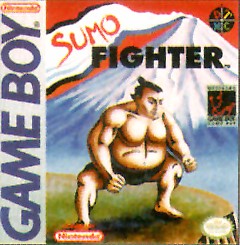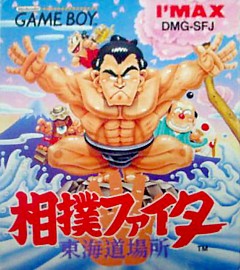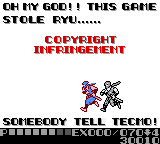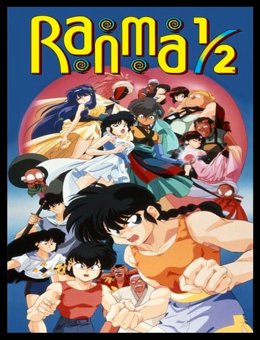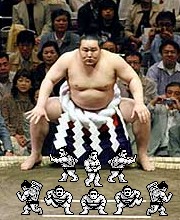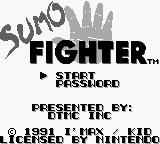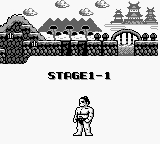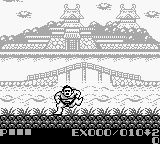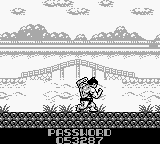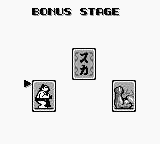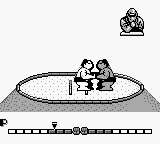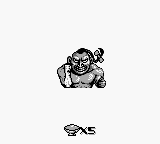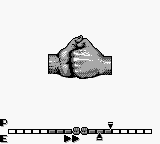As we at Gaming Sanctuary say often, many games and things have been given a chance in the U.S. in one way or another, though most come veiled in secrecy or are scarce to acquire. This game on the other hand, while rare, does not hide what it is meant to represent. Unlike games like Maru's Mission which was edited in a number of ways, here we have a game based around a SUMO WRESTLER which wasn't nearly edited at all. In other words, Japan tried to let Americans embrace a hero that not only embodies many popular concepts and core principals that the people of Japan cherish, but it was also a chance for us to perhaps take a liken to Sumo Wrestlers and maybe feel more in-tune with their culture. Many people think that U.S. gamers never received a game with a Sumo Wrestler or a Sumo Wrestling game in general, but alas, we did. It's a pretty nice game that was doomed to fail due to poor advertising, limited quantities and even a general lack of understanding. This game became known in the U.S. as "Sumo Fighter". I have to thank DTMC though...they tried to publish wierd games in the states without butchering them too much (Ranma 1/2: Hard Battle and Firestriker are some of their U.S. localizations). What exactly does this game have in store for the player?
In this game, you will assume the role of Bon-chan, a powerful Sumo Wrestler on par with a true Yokozuna (who isn't quite as tubby as the U.S. boxart would lead you to believe) that must rescue a beautiful kimono-wearing damsel in distress from monsters, freaks, and evil overlords. On his merry quest, Bon-chan will travel across a semi-fictional version of Japan spanning fifteen levels of danger and excitement. Ninjas, wolves, and giant hulking bosses are the least of your worries...because most games like this also make you fear bottomless chasms that strip away your lives.
Graphically speaking, Sumo Fighter is pretty nice looking for an early Game Boy title. It has detailed backdrops, fluid motions and large, detailed sprites. You can actually depict just how ripped Bon-chan is when he's stationary and more so with every manuever he makes such as stretching his meaty arms and posing for the camera. Everything has a nice, clean look, and it's a good way to depict how some of the things in Japan would look, such as towering daimyo castles, large bamboo shoots, "big" mountains (literally...it's written in Japanese right on them) and numerous other things. The audio is also pretty nice with a definitive Japanese feel. You will hear the tracks in the game quite a few times though since levels will reuse tunes throughout the game, and the sound effects are standard fair.
Sumo Fighter is a bit of a treat when it comes to the gameplay department, because it squeezes numerous concepts into one. DTMC was pretty smart when they decided what game they should bring to the U.S. that starred a Sumo Wrestler. Should they have published a standard Sumo Wrestling game? Should they have published a standard platforming game? Should they have published a standard RPG? Nah...DTMC wanted to represent Sumo Wrestlers in a way that few other Japanese Sumo (or "Oozumou") games could. They looked down the list of games they could use and saw one that stood out: A Sumo Wrestler in a platform style game with RPG elements and Sumo Wrestling aesthectics all rolled into one! As such, U.S. gamers were given the honor of playing the enigmatic I'Max and successful KID's Japanese brain child, "Sumo Fighter: Toukaidou Basho", which was simply dubbed Sumo Fighter in the states. Seeing as Toukaido Basho in this instance is more refering to Bon-chan's travels along the Toukaido trail, it is unsurprising that you will make numerous stops in this game at various locations reminiscent of the Toukaido subdivisions and Edo period. I'm no expert on the matter, but all these things give the game an even greater Japanese feel.
Sumo Fighter's premise is simple enough. He can push foes, grab foes and toss them off the screen, do mighty Sumo stomps to rattle the Earth (stunning and injuring foes), grab power-ups and more. As he fights, he will come across items that give him either one experience point (EXP here on) or five EXP. When Bon-chan gains enough EXP, he can level up one of three categories: "Palm" (Strength: It allows him to do more damage and smash tougher objects in succession, etc.), "Foot" (Intimidation: His stomps take more life and have more tenacity) and "Heart" (Life: You can withstand more damage). However, while these things can create a fairly standard Action/RPG, there is another element to the equation as well.
Scattered across most levels lies Bonus Stages. Once you find one, you have access to three different games: "Thumb Wrestling", "Arm Wrestling", and "Sumo Wrestling". You must choose one of three cards and the game you play is random, though every game has one card, "Suka", which will make you lose and have Bon-chan saying "Oh my god." (which was edited in the U.S. version to say "Oh no"). All the bonus games more or less function the same: you have to time button presses to hit the center region of a bar to beat your opponent. The closer you hit towards the middle, the more advantageous you will be. In Thumb Wrestling, you have opportunities to break free and pin your opponent. In Arm Wrestling, you have to drop your ugly foes' arm to achieve victory. In Sumo Wrestling, you must push the dark Sumo Wrestler out of the ring. All bonus games reward you with generous amounts of EXP and are ideal to having an easier time with this game. Needless to say, if you can't find the bonus stages, you will have a much harder time (though they are usually in obvious spots).
Another interesting feature of this game is its numerous playthroughs. In order to get all the ending text and credits, you have to finish the game three times. Each playthrough gets harder and the higher difficulties also pit you against new enemies as well as giving bosses extra special moves. Some enemies even have nasty characteristics such as kimono-wearing women with large heads who drop skulls when defeated which will drop your life one level if picked up. I guess I should say that Bon-chan certainly has his work cut out for him! The game would be a little easier if it didn't have a few pet peeves of mine, such as Bon-chan's slow turning and stomping speed. He also has a running headbutt attack that is more trouble than it's worth. I personally don't think the game has enough substance to warrant three playthroughs either, but the added comfort of a password system alleviates that problem greatly.
All in all, Sumo Fighter is a pretty good game that sadly never got the attention it deserved. Who knows, if this game had sold well enough, we might actually have seen more games starring Sumo Wrestlers. I guess since a game that tried to combine the best of numerous worlds failed to impress, most publishers just threw in the towel. I can say that I was a lot more impressed with this game than most standalone Oozumou titles.
- Written by Bel Cain The Eternal -
|
